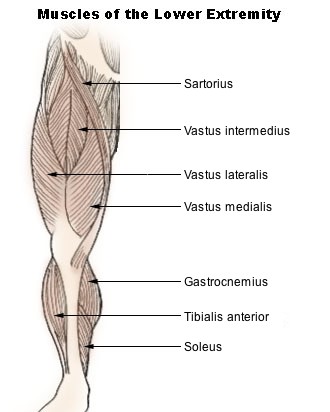- Calf muscle
Infobox Muscle
Name = PAGENAME
Latin = sura
GraySubject = 129
GrayPage = 482

Caption = Side view of leg musculature.

Caption2 = Human calf
Origin =
Insertion =
Blood =posterior tibial artery
Nerve =tibial nerve
Action =plantarflexion
Antagonist =
DorlandsPre = s_29
DorlandsSuf = 12772656
The calf or gastroc-soleus is a pair ofmuscle s—the gastrocnemius and soleus—at the back of the lowerhuman leg .The gastroc-soleus complex is connected to the foot through the
Achilles tendon , and contract to induceplantar flexion and stabilization of the ankle complex in the transverse plane.Function
Functional activities include primarily movement in the sagittal plane, stabilization during locomotion (walking, running) and power jumping.
Calf strain (torn calf muscle)
A torn calf muscle happens when the calf muscle is pulled apart from the Achilles tendon. Severe pain is felt by the victim – you may think you've just been hit in the leg and hear a "pop." Sudden pain is felt around the leg.
This injury happens during acceleration or changes in direction. The torn calf muscle may spasm, and contract forcefully. The toes will point down. Bruises can show up in the leg, foot and ankle due to pooling of blood from internal bleeding. It may take some time for the bruises to occur, from hours to days depending upon where the tear occurred. The circumference of the leg will most certainly increase.
This injury may take several months to heal. Its important not to continue the exercise if muscle is torn as
internal bleeding is taking place. See a doctor immediately after muscle is torn to get you on a rehabilitation routine.ee also
*
Triceps surae External links
*
Wikimedia Foundation. 2010.
